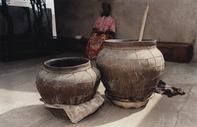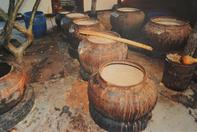
The Use of Pots
Arts and Crafts in Rural South Africa
Communities like the Bantwane often preserve old pots which are used for brewing beer.
The value ascribed to these vessels lies mainly in the fact that beer plays an important role in rituals associated with the homestead's ancestors.
The Nala family, most of whom live in a remote rural homestead in the Kranskop district of KwaZulu-Natal, has achieved international acclaim for their finely executed pots. Some are decorated with motifs taken from popular sources like Lion matchboxes.
Venda pots are decorated with distinctive patterns. Once incised on the surface of the pot, soot, graphite or shoe polish is used to accentuate these designs. The Mukondeni Pottery factory, established by a group of women near Elim in Northern Limpopo, now makes pots like these for external markets.
While large pots are generally used for brewing beer, people drink this beer from smaller vessels. Today, those made by Tsonga potters are decorated with bright coloured commercial paints.
On ritual occasions, smaller pots are passed from one person to another, thus reinforcing the sense of community fostered by these occasions. In most rural communities, drinkers deliberately spill some of the beer brewed for these events to feed and acknowledge the presence of the ancestors.
Rural women around South Africa commonly carry pots and other containers on their heads. Most of them learn the art of balancing surprisingly large vessels, which is done with the aid of scarves or woven grass rings, at a very early age, from their mothers or other female relatives.
Gourds are often used to decant beer or water from clay pots. Forced to rely on water obtained from communal wells or rivers, rural communities generally wash their hands in enamel containers before eating their food.
Most communities treasure large pots used for cooking, storing water and other domestic purposes. In some cases, these pots are passed down from one generation to another.
By
Professor Sandra Klopper














